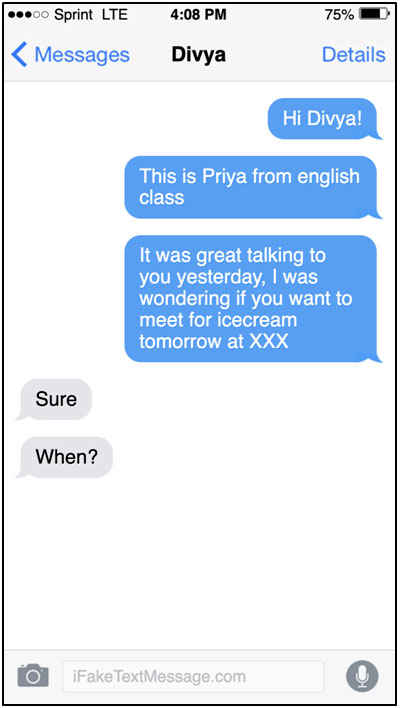Riya is a 15 year old girl who missed a few days of school because she was sick. Now she needs help with her algebra homework because she did not attend the class where they learned the concepts. She is trying to text her classmate Katy for help. But she finds herself being anxious.
“What if she’s busy? I don’t want to bother her!”
“Is my question really stupid?”
“Is she going to think I’m dumb if I ask her for help?”
“Should I not reach out?”
Just consider…you are a parent and your teen daughter or son is agonizing over the text they want to send to their friend to ask them if they want to hang out or need some help with classwork.
Understanding a Teen’s Stress Over Texting
Strategies to reduce stress
As a parent, witnessing your teen daughter or son agonize over sending a text to their friends to hang out or solve a misunderstanding can be a learning experience. Here’s what they might be experiencing:
- Anxiety and Excitement: The mix of nervousness about how their message will be received, coupled with the excitement of taking a step towards expressing an interest in making a new friend.As a parent, discussing with your teenager that accepting some anxiety is normal in these situations helps them a great deal in normalizing these interactions. It is normal to feel excited and sometimes anxious when texting another person and anticipating their response.
- Fear of Rejection: Concern about the possibility that their friend might not respond in the way they hope, leading to feelings of vulnerability.As a parent, you can discuss with your teenager that everyone has different ways of responding to requests on text messages and in person. It is important to learn to not take people’s responses personally. If a response from a friend is not to your liking, do not think of this response as rejection or as failure. You can reach out again in a few days or consider talking to another person.
- Pressure to be Perfect: The desire to craft a message that conveys their feelings without coming off as too eager or indifferent.Know that nothing is perfect. When texting, simply choose to be yourself and you will attract true friendships.
- Uncertainty: The struggle with not knowing how much to share, worrying about overstepping boundaries or not saying enough to spark interest.We can see that teenage emotions are complex, and something as simple as sending a text can cause intense anxiety for some. This anxiety might even lead to avoiding social situations, as a teen may agonize over asking a friend to hang out via text.
 As a parent, discussing these seemingly simple topics with your children and teenagers, and educating them on texting etiquette, can significantly reduce their anxiety. This approach improves their confidence in socializing and helps them avoid overthinking their digital communication.
As a parent, discussing these seemingly simple topics with your children and teenagers, and educating them on texting etiquette, can significantly reduce their anxiety. This approach improves their confidence in socializing and helps them avoid overthinking their digital communication.
Texting, or the act of sending and receiving short messages via mobile devices, has become an integral part of daily communication for many people around the world.
It offers several benefits as well as potential perils that users should be aware of.
Let’s do a deep dive into both aspects:
Thrills of Texting

- Instant Communication: Texting allows for immediate interaction, making it possible to stay in touch with friends, family, and colleagues anytime and anywhere.For example, you can quickly make plans with a group of friends to watch a movie and have dinner later.
- Convenience: It’s a quick and easy way to send a message without the need for a long conversation.This is particularly useful in situations where talking on the phone is impractical and time consuming.
- Privacy: Text messages can be sent and received discreetly, without drawing attention.
- Multimedia Sharing: Beyond just text, sharing photos, videos that are fun and personal such as birthday or other celebrations can be quick.For example, you can quickly get some fashion advice from a good friend on what to wear if you cannot make up your mind!
Perils of Texting
- Miscommunication: Without the nuances of tone, body language, and facial expressions, texts can easily be misinterpreted, leading to misunderstandings.
An example of miscommunication in texting:

An issue with texting is that it is difficult to grasp the other person’s emotions in a conversation. For example, in the above screenshot, Riya is trying to ask her friend Ana to hangout with her. Riya may already be feeling insecure about how Ana feels about her, but Ana’s ambiguous reply may increase her anxiety. Is Ana actually interested in meeting? Or is she being polite? Did Riya’s request annoy her?
- Overuse: Excessive texting can lead to addiction, social isolation, and even physical problems like text neck or eye strain.For example, trying to solve a misunderstanding over texting could make the problem worse. It is much better to discuss any misunderstandings in person where one can be in tune with the other person.
- Privacy and Security Risks: Text messages can be intercepted, and sensitive information can be exposed to unauthorized individuals.Unless texting a very trusted friend or parent, it is important to not divulge personal information in the form of texting or pictures.This is particularly important as teenagers may get into heated emotions with friends or peers and may divulge something that may be private.If you feel you tend to overshare or say something you shouldn’t, try pausing for 10 seconds after typing a message before you send it. This will allow you to reread the message and decide if it is a good idea to send.
- Cyberbullying: Texting can be a medium for bullying, allowing harassers to target victims anonymously and persistently.Use your privacy settings to block and report anyone who is harassing you online. You can also speak to a trusted adult. Do not be afraid to stand up for yourself.
Summary

While texting offers a great fun and efficient way to communicate, it’s
important to use it wisely to reduce the risks associated with its perils.
Balancing the benefits of texting with an awareness of its drawbacks can help ensure it remains a positive part of our modern digital lives.
Understanding the nuances of texting, including its positive aspects and challenges, is crucial for building healthy relationships and reducing the stress associated with this form of digital communication. The sooner teenagers learn these skills, the better equipped they will be to navigate the world of modern digital relationships.
The key is balancing in person versus online communications!
Do encourage your teenager to meet more often in person and exercise that socializing muscle!
